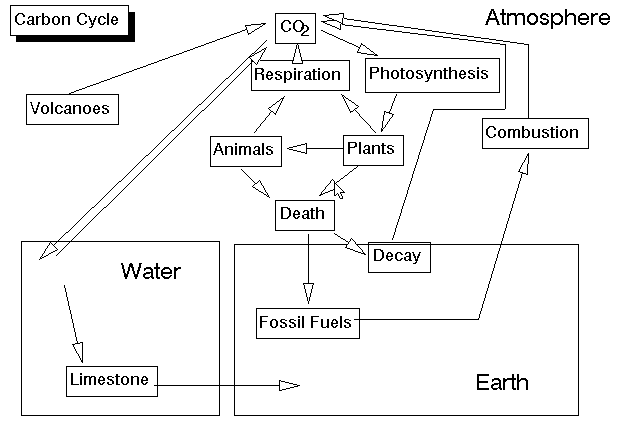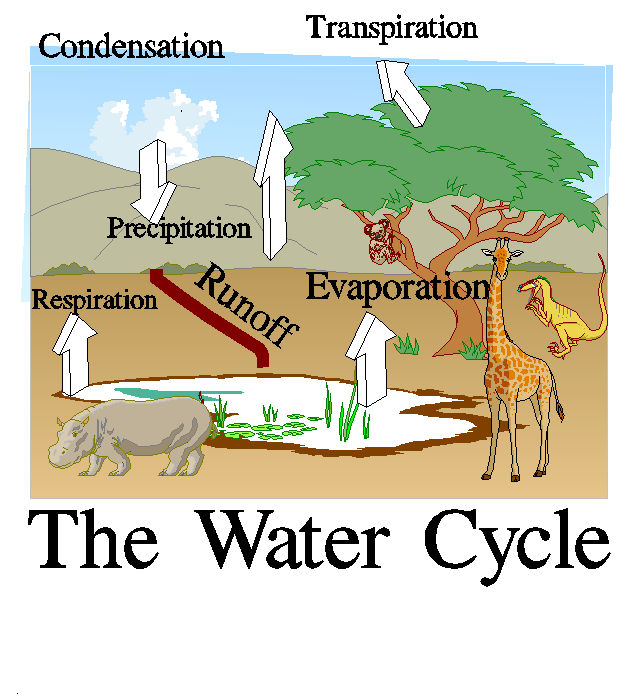![]()
SvS Biology 2000 - No
Webbuttal
8.2.2 There is a flow of energy and
matter in an ecosystem
1. There are many minerals and elements that are the building blocks for all life. Which of the following contains a component that is NOT strictly a part of this?
(A) carbon and phosporous
(B) nitrogen and water
(C) oxygen and sulfur
(D) hydrogen and salts
2.(a) carbon cycle

(b) water cycle

3. (a) Nitrogen fixation
(b) Decomposers
4.
The green pigment in leaves is called CHLOROPHYLL, it enables plants to grow by making their own food. The process which uses this pigment is known as PHOTOSYNTHESIS , and uses WATER, carbon dioxide and energy from sunlight to produce the simple sugar, GLUCOSE. OXYGEN gas is a waste product of the process, some of which is used for RESPIRATION , and the rest is released into the atmosphere.
5. Fill in the blanks in the following paragraph:
Cellular respiration is a series of chemical reactions that occur in all cells 24 hours per day. In cellular respiration, GLUCOSE is broken down in the presence of OXYGEN gas and converted to ATP within the cell. The byproducts of the process are WATER and CARBON DIOXIDE. ATP is then used as needed to release energy for cellular functions like growth, reproduction and movement. Cellular respiration takes place in the organelles called MITOCHONDRIA within all eukaryotic cells.
6(a) Food Chains
(b)
dingo
bird
caterpillar
plant
(c) Caterpillar, Bird, Dingo
(d) Dingo, Bird
7(a)(i) Heat
(ii) emmigration
(b)(i) eg: grasshopper and
mouse, or rabbit and mouse, or grasshopper and rabbit
(ii) effect on hawks? decrease
(iii) effect on mice? increase
(c) Sometimes matter accumulates in an ecosystem. This process is known as "Biomagnification." Read the following extract from http://www.marietta.edu/~biol/102/ecosystem.html
The "best" example of biomagnification comes from DDT. This long-lived pesticide (insecticide) has improved human health in many countries by killing insects such as mosquitoes that spread disease. On the other hand, DDT is effective in part because it does not break down in the environment. It is picked up by organisms in the environment and incorporated into fat. Even here, it does no real damage in many organisms (including humans). In others, however, DDT is deadly or may have more insidious, long-term effects. In birds, for instance, DDT interferes with the deposition of calcium in the shells of the bird's eggs. The eggs laid are very soft and easily broken; birds so afflicted are rarely able to raise young and this causes a decline in their numbers. This was so apparent in the early 1960's that it led the scientist Rachel Carson to postulate a "silent spring" without the sound of bird calls. Her book "Silent Spring" led to the banning of DDT, the search for pesticides that would not biomagnify, and the birth of the "modern" environmental movement in the 1960's. Birds such as the bald eagle have made comebacks in response to the banning of DDT in the US. Ironically, many of the pesticides which replaced DDT are more dangerous to humans, and, without DDT, disease (primarily in the tropics) claims more human lives.
(i) It does not break
down in the environment
It is incorporated into fat
(ii) Organisms eat a high quantity of their food source. The DDT then accumulates in their fat tissues and remains in their body. Higher order consumers ingest high proportions of these animals and accumulate a greater concentration of the DDT. This means that non target populations become affected.
8(a)

(a) (i)
cristae - projectiles inside organelle
(ii) matrix - area inbetween cristae containing dissolved substances
(b) Answer True or false to
the following about mitochondria:
(i) they may contain DNA True
(ii) they are responsible for
carrying out photosynthesis False
(iii) they are only present
in animal cells False
(iv) they may contain
ribosomes True
(v) the pectoral muscle cells
of a hummingbird will contain more of these than will a human heart cell. True
Now whaddya want?
S. van Strien